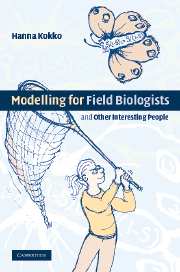Book contents
- Frontmatter
- Contents
- Preface
- 1 Modelling philosophy
- 2 Population genetics
- 3 Quantitative genetics
- 4 Optimization methods
- 5 Dynamic optimization
- 6 Game theory
- 7 Self-consistent games and evolutionary invasion analysis
- 8 Individual-based simulations
- 9 Concluding remarks
- Appendix: A quick guide to MATLAB
- References
- Index
Appendix: A quick guide to MATLAB
Published online by Cambridge University Press: 05 June 2012
- Frontmatter
- Contents
- Preface
- 1 Modelling philosophy
- 2 Population genetics
- 3 Quantitative genetics
- 4 Optimization methods
- 5 Dynamic optimization
- 6 Game theory
- 7 Self-consistent games and evolutionary invasion analysis
- 8 Individual-based simulations
- 9 Concluding remarks
- Appendix: A quick guide to MATLAB
- References
- Index
Summary
This is a quick and informal guide to Matlab, arranged in five lessons: the basics, functions, matrix notation, truth values and ‘for’ loops. This gives the most basic building blocks, but Matlab can do a lot more. To discover more, try the commands help (e.g. help plot) and lookfor (e.g. lookfor correlation). While help gives the syntax for a single command, lookfor finds all potentially relevant functions available.
Lesson 1 The very basics
The ‘Mat‘ in Matlab has nothing to do with maths but with matrices: the program is a ‘Matrix Laboratory’. However, one does not have to worry about the details of matrix algebra: that's where the program's roots are, but it has evolved into something quite versatile.
Information
- Type
- Chapter
- Information
- Modelling for Field Biologists and Other Interesting People , pp. 194 - 206Publisher: Cambridge University PressPrint publication year: 2007
